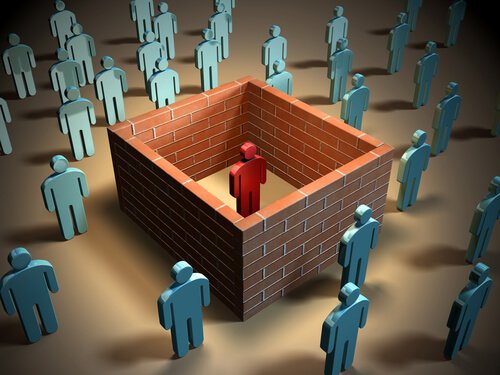Hikikomori: Social Withdrawal Syndrome

In the last few years, there has been an alarming increase in the prevalence of social withdrawal syndrome. This phenomenon is characterized by voluntary reclusion and solitude. The people afflicted by this condition perceive their external world as hostile, violent, and aggressive. Because of that, these people seek extreme solitary confinement.
This syndrome was originally known by the name hikikomori which means “being confined” in Japanese. It was coined by Japanese psychiatrist Tamaki Saito in 2000. This doctor defined it as a new social illness based on intentional self-reclusion for a period of at least 6 months. Most of the time, social withdrawal syndrome affects young adults who don’t have any type of social interaction, educational activities, or work commitments.
Social withdrawal
People who suffer from social withdrawal syndrome tend to avoid any type of contact with the outside world. Their fear of leaving their comfort zone is extreme. In order to do this, the afflicted person totally isolates themselves. They lock themselves up in their rooms for long periods of time. Their main reason for not going out is that they want to be alone.
These people slowly cut off all communication channels until they safely enclose themselves in their small spaces. At first, they shut themselves in their rooms for days. Then, they do it for weeks and it can even end up going on for years. They spend their days sleeping, watching television, or engrossed in virtual video game worlds.
In most cases, their circle of friends is very small or nonexistent. Young people with social isolation syndrome have contact with the outside world through electronic devices. People who are severely afflicted don’t even engage in online interaction.
Changes in their circadian rhythms
Social withdrawal syndrome causes temporary oscillations in the afflicted person’s main biological variables. For example, these young people may sleep during the day and play video games at night. When it comes to meals, people with this syndrome eat them at odd hours. They eat without restrictions and don’t care about food’s nutritional value. They may frequently have fast food delivered to them or live off of pre-cooked meals.
By the same token, they don’t care about hygiene. There typically tends to be a lot of garbage around them. This is due to their refusal to go out to the street or even leave their room, even to throw away the garbage from the fast food they consume.
The parents’ role
Shinguru is a Japanese term that roughly means “parasite single” in English. It refers to adults who live with their parents under their care and guardianship. They seek to enjoy a comfortable life they wouldn’t be able to get on their own.
Teens with this syndrome don’t have much of a relationship with the other members of their family. Sometimes, these young people can scare their parents and behave aggressively. Others appear to be consumed by a sadness that turns into anxiety and depression over time. In certain occasions, this reclusive lifestyle and deep dissatisfaction make them commit suicide.
Social withdrawal syndrome subtypes
All of social withdrawal syndrome’s subtypes are characterized by voluntary reclusion. But all the people with this affliction don’t close themselves off in the same way or to the same extent. Experts have identified four types of hikikomori:
- Pre-hikikomori: These people go out to attend college or university courses. However, they try to avoid any other type of social interaction as much as possible.
- Social hikikomori: They refuse to work or study, but they have some social relationships. These are mostly online relationships.
- Tachisukumi-gata: This type of person shows marked social phobia. When they face the external world, their fear paralyzes them.
- Netogehaijin: Literally means “computer zombie”. These young people are completely isolated and spend all their time on the computer or in other virtual settings.

Some hypotheses that may explain the hikikomori phenomenon
Currently, we don’t know the causes that would explain this psychological alteration. Some theorists believe that technology itself makes these people lose contact with reality. Others believe that it’s the product of excessive family pressure that leads them to withdrawal. This being the case, their parents’ expectations regarding their future makes them break communication with them first. Little by little, they come to do the same with other people. Some theorists also mention socioeconomic or simply economic factors.
This syndrome was described for the first time in Japan. As such, it was first believed to be linked exclusively to the individualistic and competitive Japanese society. In that country, millions of people are afflicted. In recent years, however, cases of this syndrome or similar issues have increased in countries such as Spain, Italy, USA, Oman, and India.
In the last few years, there has been an alarming increase in the prevalence of social withdrawal syndrome. This phenomenon is characterized by voluntary reclusion and solitude. The people afflicted by this condition perceive their external world as hostile, violent, and aggressive. Because of that, these people seek extreme solitary confinement.
This syndrome was originally known by the name hikikomori which means “being confined” in Japanese. It was coined by Japanese psychiatrist Tamaki Saito in 2000. This doctor defined it as a new social illness based on intentional self-reclusion for a period of at least 6 months. Most of the time, social withdrawal syndrome affects young adults who don’t have any type of social interaction, educational activities, or work commitments.
Social withdrawal
People who suffer from social withdrawal syndrome tend to avoid any type of contact with the outside world. Their fear of leaving their comfort zone is extreme. In order to do this, the afflicted person totally isolates themselves. They lock themselves up in their rooms for long periods of time. Their main reason for not going out is that they want to be alone.
These people slowly cut off all communication channels until they safely enclose themselves in their small spaces. At first, they shut themselves in their rooms for days. Then, they do it for weeks and it can even end up going on for years. They spend their days sleeping, watching television, or engrossed in virtual video game worlds.
In most cases, their circle of friends is very small or nonexistent. Young people with social isolation syndrome have contact with the outside world through electronic devices. People who are severely afflicted don’t even engage in online interaction.
Changes in their circadian rhythms
Social withdrawal syndrome causes temporary oscillations in the afflicted person’s main biological variables. For example, these young people may sleep during the day and play video games at night. When it comes to meals, people with this syndrome eat them at odd hours. They eat without restrictions and don’t care about food’s nutritional value. They may frequently have fast food delivered to them or live off of pre-cooked meals.
By the same token, they don’t care about hygiene. There typically tends to be a lot of garbage around them. This is due to their refusal to go out to the street or even leave their room, even to throw away the garbage from the fast food they consume.
The parents’ role
Shinguru is a Japanese term that roughly means “parasite single” in English. It refers to adults who live with their parents under their care and guardianship. They seek to enjoy a comfortable life they wouldn’t be able to get on their own.
Teens with this syndrome don’t have much of a relationship with the other members of their family. Sometimes, these young people can scare their parents and behave aggressively. Others appear to be consumed by a sadness that turns into anxiety and depression over time. In certain occasions, this reclusive lifestyle and deep dissatisfaction make them commit suicide.
Social withdrawal syndrome subtypes
All of social withdrawal syndrome’s subtypes are characterized by voluntary reclusion. But all the people with this affliction don’t close themselves off in the same way or to the same extent. Experts have identified four types of hikikomori:
- Pre-hikikomori: These people go out to attend college or university courses. However, they try to avoid any other type of social interaction as much as possible.
- Social hikikomori: They refuse to work or study, but they have some social relationships. These are mostly online relationships.
- Tachisukumi-gata: This type of person shows marked social phobia. When they face the external world, their fear paralyzes them.
- Netogehaijin: Literally means “computer zombie”. These young people are completely isolated and spend all their time on the computer or in other virtual settings.

Some hypotheses that may explain the hikikomori phenomenon
Currently, we don’t know the causes that would explain this psychological alteration. Some theorists believe that technology itself makes these people lose contact with reality. Others believe that it’s the product of excessive family pressure that leads them to withdrawal. This being the case, their parents’ expectations regarding their future makes them break communication with them first. Little by little, they come to do the same with other people. Some theorists also mention socioeconomic or simply economic factors.
This syndrome was described for the first time in Japan. As such, it was first believed to be linked exclusively to the individualistic and competitive Japanese society. In that country, millions of people are afflicted. In recent years, however, cases of this syndrome or similar issues have increased in countries such as Spain, Italy, USA, Oman, and India.
This text is provided for informational purposes only and does not replace consultation with a professional. If in doubt, consult your specialist.







